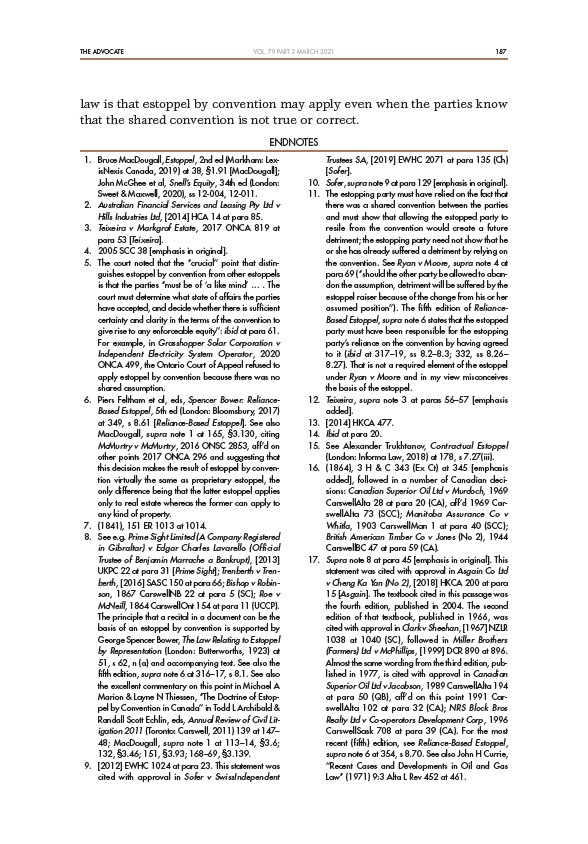
THE ADVOCATE 187
VOL. 79 PART 2 MARCH 2021
law is that estoppel by convention may apply even when the parties know
that the shared convention is not true or correct.
ENDNOTES
1. Bruce MacDougall, Estoppel, 2nd ed (Markham: LexisNexis
Canada, 2019) at 38, §1.91 MacDougall;
John McGhee et al, Snell’s Equity, 34th ed (London:
Sweet & Maxwell, 2020), ss 12-004, 12-011.
2. Australian Financial Services and Leasing Pty Ltd v
Hills Industries Ltd, 2014 HCA 14 at para 85.
3. Teixeira v Markgraf Estate, 2017 ONCA 819 at
para 53 Teixeira.
4. 2005 SCC 38 emphasis in original.
5. The court noted that the “crucial” point that distinguishes
estoppel by convention from other estoppels
is that the parties “must be of ‘a like mind’ … . The
court must determine what state of affairs the parties
have accepted, and decide whether there is sufficient
certainty and clarity in the terms of the convention to
give rise to any enforceable equity”: ibid at para 61.
For example, in Grasshopper Solar Corporation v
Independent Electricity System Operator, 2020
ONCA 499, the Ontario Court of Appeal refused to
apply estoppel by convention because there was no
shared assumption.
6. Piers Feltham et al, eds, Spencer Bower: Reliance-
Based Estoppel, 5th ed (London: Bloomsbury, 2017)
at 349, s 8.61 Reliance-Based Estoppel. See also
MacDougall, supra note 1 at 165, §3.130, citing
McMurtry v McMurtry, 2016 ONSC 2853, aff’d on
other points 2017 ONCA 296 and suggesting that
this decision makes the result of estoppel by convention
virtually the same as proprietary estoppel, the
only difference being that the latter estoppel applies
only to real estate whereas the former can apply to
any kind of property.
7. (1841), 151 ER 1013 at 1014.
8. See e.g. Prime Sight Limited (A Company Registered
in Gibraltar) v Edgar Charles Lavarello (Official
Trustee of Benjamin Marrache a Bankrupt), 2013
UKPC 22 at para 31 Prime Sight; Trenberth v Trenberth
, 2016 SASC 150 at para 66; Bishop v Robinson
, 1867 CarswellNB 22 at para 5 (SC); Roe v
McNeill, 1864 CarswellOnt 154 at para 11 (UCCP).
The principle that a recital in a document can be the
basis of an estoppel by convention is supported by
George Spencer Bower, The Law Relating to Estoppel
by Representation (London: Butterworths, 1923) at
51, s 62, n (a) and accompanying text. See also the
fifth edition, supra note 6 at 316–17, s 8.1. See also
the excellent commentary on this point in Michael A
Marion & Layne N Thiessen, “The Doctrine of Estoppel
by Convention in Canada” in Todd L Archibald &
Randall Scott Echlin, eds, Annual Review of Civil Litigation
2011 (Toronto: Carswell, 2011) 139 at 147–
48; MacDougall, supra note 1 at 113–14, §3.6;
132, §3.46; 151, §3.93; 168–69, §3.139.
9. 2012 EWHC 1024 at para 23. This statement was
cited with approval in Sofer v SwissIndependent
Trustees SA, 2019 EWHC 2071 at para 135 (Ch)
Sofer.
10. Sofer, supra note 9 at para 129 emphasis in original.
11. The estopping party must have relied on the fact that
there was a shared convention between the parties
and must show that allowing the estopped party to
resile from the convention would create a future
detriment; the estopping party need not show that he
or she has already suffered a detriment by relying on
the convention. See Ryan v Moore, supra note 4 at
para 69 (“should the other party be allowed to abandon
the assumption, detriment will be suffered by the
estoppel raiser because of the change from his or her
assumed position”). The fifth edition of Reliance-
Based Estoppel, supra note 6 states that the estopped
party must have been responsible for the estopping
party’s reliance on the convention by having agreed
to it (ibid at 317–19, ss 8.2–8.3; 332, ss 8.26–
8.27). That is not a required element of the estoppel
under Ryan v Moore and in my view misconceives
the basis of the estoppel.
12. Teixeira, supra note 3 at paras 56–57 emphasis
added.
13. 2014 HKCA 477.
14. Ibid at para 20.
15. See Alexander Trukhtanov, Contractual Estoppel
(London: Informa Law, 2018) at 178, s 7.27(iii).
16. (1864), 3 H & C 343 (Ex Ct) at 345 emphasis
added, followed in a number of Canadian decisions:
Canadian Superior Oil Ltd v Murdoch, 1969
CarswellAlta 28 at para 20 (CA), aff’d 1969 CarswellAlta
73 (SCC); Manitoba Assurance Co v
Whitla, 1903 CarswellMan 1 at para 40 (SCC);
British American Timber Co v Jones (No 2), 1944
CarswellBC 47 at para 59 (CA).
17. Supra note 8 at para 45 emphasis in original. This
statement was cited with approval in Asgain Co Ltd
v Cheng Ka Yan (No 2), 2018 HKCA 200 at para
15 Asgain. The textbook cited in this passage was
the fourth edition, published in 2004. The second
edition of that textbook, published in 1966, was
cited with approval in Clark v Sheehan, 1967 NZLR
1038 at 1040 (SC), followed in Miller Brothers
(Farmers) Ltd v McPhillips, 1999 DCR 890 at 896.
Almost the same wording from the third edition, published
in 1977, is cited with approval in Canadian
Superior Oil Ltd v Jacobson, 1989 CarswellAlta 194
at para 50 (QB), aff’d on this point 1991 CarswellAlta
102 at para 32 (CA); NRS Block Bros
Realty Ltd v Co-operators Development Corp, 1996
CarswellSask 708 at para 39 (CA). For the most
recent (fifth) edition, see Reliance-Based Estoppel,
supra note 6 at 354, s 8.70. See also John H Currie,
“Recent Cases and Developments in Oil and Gas
Law” (1971) 9:3 Alta L Rev 452 at 461.